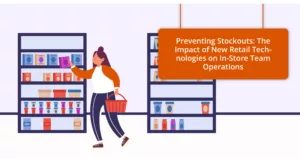The rise of self-service in the retail sector has long distanced sales advisors from the shop floor. Choosing for oneself – running shoes, loose-leaf tea, a digital camera, or even the ideal Christmas toy – once became the norm in consumer behavior. In recent years, however, changing habits and ever-increasing customer expectations, combined with increasingly complex competition, have pushed retailers to reinvent themselves in order to offer a high-quality, distinctive sales experience.
This transformation of stores to adapt to new demands and maintain their relevance has highlighted one key fact: customers need and want service – particularly in Specialized Retail Stores, but also in Grocery Superstores! However, it’s been shown that when it comes to customer advice, expectations are not always met, simply because sales advisors are not present in the aisle at the right time.
Work overload during peak hours, poor task distribution, underestimation of required staff, or assignment to low value-added tasks… the causes are many but all point to a common issue: disorganized activity.
Below, we present the golden rules to follow in the field to ensure that your staff are available to deliver a quality customer journey and experience.
Modeling daily operations
Start by identifying all the processes and tasks specific to your store, and categorize them into priority tasks (e.g., customer advice, shelf-stocking), mandatory tasks (e.g., checking expiration dates, handling stock shortages), and time-constrained tasks (e.g., order placements, briefings). Then break them down into elementary actions, or operations.
Next, assign a time value to each task based on a time standard, established by timing the task and validated by your staff.
Also define time-related criteria that affect how long operations take.
These three steps enable you to model a typical workday and assign it to each employee. This also works when modeling a typical week!t
Anticipating customer and product flows in the model
The goal is to use the time-related criteria that influence how long a task takes to complete (identified in the previous phase), in order to calculate it even more precisely.
First, collect data on actual flows, such as the volume of goods delivered, upcoming promotions, and product orders to prepare for home delivery or click & collect.
Then, identify forecast data such as the number of items expected to require customer advice, and total hours spent on checkout duties.
This step lets you estimate the workload based on product flows and time of day, taking into account seasonality, commercial calendars (e.g., holidays), and external factors like weather or local events. Your organization thus evolves from reacting to customer and product flows to anticipating them.
Evaluating and fairly distributing workload
Once the two previous steps are completed, you can now calculate the actual time needed for tasks and map it on a schedule. This lets you compare workload and working hours for each team member, so that tasks can be distributed equitably.
In turn, you can identify available time in each schedule and spot underused resources that could be reallocated to customer advice. This relies heavily on versatility and flexibility, which are key in specialized retail: they boost efficiency and collaboration, strengthen employee autonomy, and broaden skillsets and organizational possibilities.
Organizational flexibility also allows you to adjust schedules based on store priorities—so more time can be allocated to customer advice (our goal here), and less to administrative tasks.
As for versatility, here are two examples:
Assigning employees whose main priority is sales advising to focus on that priority during peak periods, while using their available time to support other tasks. For example, in a gaming specialty store, a salesperson who is an expert on the latest game release will be assigned primarily to advising customers—handling all their questions at a given time—then will help restock shelves once their expert advice has led customers to clear out the store.
Assigning staff whose core role is not customer advice to advisory duties when store priorities shift, or allocating more staff to advisory roles based on the day. For instance, a fashion store might assign more people to fitting rooms on Saturday afternoons to help customers, guide them to changing rooms, or fetch alternative sizes. This smoothens the customer experience and reduces friction like waiting times at fitting rooms and checkouts.
The big winners are, of course, the customers: better welcomed and better advised, the perceived quality of the store and the brand is enhanced, and the store becomes a true experiential space.
A notable example is Decathlon, which set up around twenty trial areas in a pilot store, allowing customers to test equipment under simulated usage conditions before purchasing. Sales staff presence is scheduled based on customer traffic to ensure they can share their full product expertise. Usefulness, human interaction, and fun come together to create a unique experience.
Reallocating hours based on concrete data also brings strong profitability gains: better customer experience increases average basket size and sales revenue—worth noting!
Customer advice remains essential in specialized retail. Reallocating time to it is therefore critical. While we’ve outlined the methodology to identify and reassign available hours to customer advice in your store operations, you’ll quickly find that tackling this manually—or with spreadsheets—creates more problems and time loss than doing nothing at all.
Only an activity management tool can support this methodology efficiently. In this regard, the SaaS platform TimeSkipper, which captures data and generates previously unavailable insights, is the most effective example.





